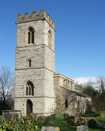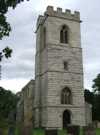For this church:    |
|
Key to Windows |
Main Church
 Detail of the Detail of thecentral figure |
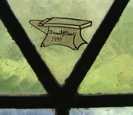 Window restorer’s Window restorer’s“anvil” mark |
1East window
The window dates from the 14th century. It has been restored and has five lights, with cusped flowing tracery, coved mullions, chamfered and rebated reveal, and hood mould.
This window has been altered several times. It was enlarged to its present size in the 14th century. Pre-1764 the window head had been walled up when a flat ceiling was inserted in the chancel; the tracery was destroyed leaving a square-headed opening with five lights.
In 1873 the walling was removed and a traceried head inserted in the new window; jambs and mullions were cleaned and re-pointed.
There are four outer lights of plain Cathedral glass. The stained glass in the central light was given by the rector in 1874. The original work was done by Messrs Hardman of Newhall Mill, Birmingham. The stained glass is of the Crucifixion. The inscription below reads:
| TO THE GLORY OF GOD AND IN MEMORY OF WILHELMINA BROWNING WHO DIED MAY 25 1874 AGED 80 THIS LIGHT IS PLACED BY HFC |
(The initials stand for Henry Fiennes-Clinton.)
The glazing was restored by David Bloet of the Anvil Company in 1988 and is signed bottom right with an anvil.
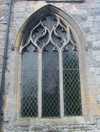 |
 |
 |
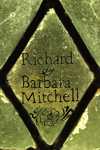 |
 |
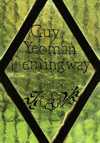 |
2Chancel, sanctuary south side
It is a restored 14th century triple lancet window with cusped ogee heads, curvilinear tracery, coved mullion, chamfered and rebated surround and hood mould with mask stops. It is considered to be among the best of its style in Nottinghamshire. There is stained glass in the centre lancet representing Christ in Majesty in the style of the 1890s. It was inserted in 1989 in memory of Guy Hemingway (d1986). This is recorded in the following extract from the PCC minutes 14 August 1989: ‘Windows were discussed, and it was decided to instruct Mr David Sears of Lincolnshire Glass Studio to fix the stained glass section which he has found for us from his own collection of restored work into the centre panel of the sanctuary window (south).’ The origin of the glass is not known. The window had been re-glazed in 1988 with the help of Richard & Barbara Mitchell, and in memory of Ida and Guy Hemingway. This information is etched in the window.
3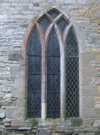 The window at east end of the south chancel aisle is early 14th century. It is a triple lancet with intersecting tracery and splayed mullion and reveal. The position of this window has been changed several times in the history of the church. When the chantry chapel was built in the 14th century the window would have been at the east end. At some point the south chancel aisle was demolished and the window inserted in the south wall arch of the chancel. In 1873 the aisle was rebuilt as a chantry and the window was returned to its present position. It has plain glass.
The window at east end of the south chancel aisle is early 14th century. It is a triple lancet with intersecting tracery and splayed mullion and reveal. The position of this window has been changed several times in the history of the church. When the chantry chapel was built in the 14th century the window would have been at the east end. At some point the south chancel aisle was demolished and the window inserted in the south wall arch of the chancel. In 1873 the aisle was rebuilt as a chantry and the window was returned to its present position. It has plain glass.
 Dedication panel Dedication panelin one of the windows |
5,6
8,9 Restored nave windows
The two windows on the south side of the south aisle of the nave, and the two windows on the north side of the nave are restored 14th century double lancets with cusped ogee heads, decorated tracery, splayed mullions and reveals. These windows are identical in style to the windows in stage 4 of the tower. Hemingway suggests that they were originally inserted at the same time as the tower was built, around 1427. All four windows are plain glass. Window 5 has an etched record that re-glazing was helped by Gweneth & Leonard Warner, and Margaret & Peter Ely. Window 6 records the help of Charles Tyrrell Chambers and Vina Cooke Chambers. Window 8 records the contribution of Denis Barker and Violet E Weatherhead. Window 9 records the contribution of the Rev Richard Camenisch and his wife Anne.
7 The window at the west end of the south aisle is a restored 14th century single lancet with cusped ogee head and chamfered reveal. The stained glass is 19th century. There is no indication of the maker but the design is typical of the period. The work on the window was done by Messrs Hardman, Newhall Mill, Birmingham. It represents the Baptism in the Jordan, and is in imitation of 13th century style. It has the inscription:
The window at the west end of the south aisle is a restored 14th century single lancet with cusped ogee head and chamfered reveal. The stained glass is 19th century. There is no indication of the maker but the design is typical of the period. The work on the window was done by Messrs Hardman, Newhall Mill, Birmingham. It represents the Baptism in the Jordan, and is in imitation of 13th century style. It has the inscription:
THIS IS MY BELOVED SON  IN WHOM I AM WELL-PLEASED |
There is also information that it was placed on 12 July 1875 by school fellows and friends of Ida Knox, who had died in the previous September.
10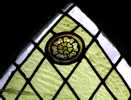 The window at the west end of the north side of the chancel is a restored late 13th century double lancet with Y tracery, splayed mullions, chamfered reveals, and hood moulds with mask stops. There is a fragment of 14th or 15th century glass at the top of the window; it is a six-petalled rose in a roundel. The rest of the window is plain glass.
The window at the west end of the north side of the chancel is a restored late 13th century double lancet with Y tracery, splayed mullions, chamfered reveals, and hood moulds with mask stops. There is a fragment of 14th or 15th century glass at the top of the window; it is a six-petalled rose in a roundel. The rest of the window is plain glass.
11 The window at the east end of the north side of the chancel has the same structure as window 10. The top section contains jumbled fragments of 14th or 15th century glass. The largest fragment is a complete shield showing six annulets in gold on a crimson ground (gules, six annulets, 3,2 and 1, or). These are the arms of Idonea Vipont, married to John de Cromwell, younger brother of Ralph, c1301. Also recognizable in other fragments are saints or angel faces, two cusp-heads, an acorn, vine-leaf trails and border pieces with yellow balls on a black triangular shape. The rest of the window is plain glass. The glass was inserted at the restoration in 1873; it was reglazed in 1988.
The window at the east end of the north side of the chancel has the same structure as window 10. The top section contains jumbled fragments of 14th or 15th century glass. The largest fragment is a complete shield showing six annulets in gold on a crimson ground (gules, six annulets, 3,2 and 1, or). These are the arms of Idonea Vipont, married to John de Cromwell, younger brother of Ralph, c1301. Also recognizable in other fragments are saints or angel faces, two cusp-heads, an acorn, vine-leaf trails and border pieces with yellow balls on a black triangular shape. The rest of the window is plain glass. The glass was inserted at the restoration in 1873; it was reglazed in 1988.
Vestry
 South side of the South side of thechurch, showing clerestory |
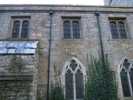 Upper level windows Upper level windowson the north side |
Clerestory
The south side plain clerestory probably added between 1490-1520.
There are three squared-headed double lancets; the windows and mouldings are in 17th century style. There are three windows on the upper level of the north side of the nave; they are not strictly part of the clerestory, but are at the same level as it. They are 15th century double lancets with chamfered and rebated square headed reveals as on the south side. The plain glass was inserted at the restoration.
Tower
The tower, built about 1427, has four stages, with windows as follows
Windows in stages 2 and 3 are glazed with plain glass; those in stage 4 have wooden louvers.


